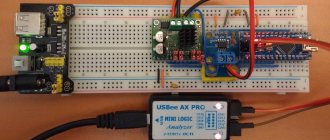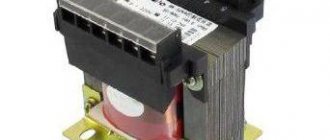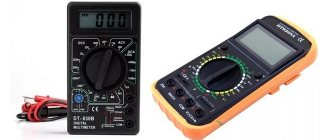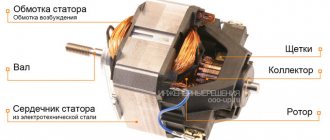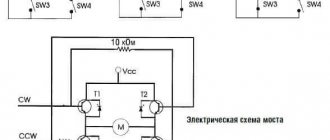When it comes to current measurement, 90% of ordinary people think of voltage measurement first. But other power parameters are no less important. Therefore, you need to understand what an AC ammeter is.
Peculiarities
As you can easily understand from the name, an ammeter is a device for determining current strength in amperes or derived multiples of the SI system. The specific unit of measurement is determined by the accuracy of each instrument. An ammeter is connected to any electrical circuit in a series circuit with respect to the section of the circuit being examined. As a result, the internal resistance of the device is critical.
Ideally, it should be reduced to zero in order to prevent the internal environment of the apparatus from affecting the object and not reduce the accuracy of the measurement.
To expand the measurement space, shunts or a transformer are used. Shunts are equipped with those devices that are designed for use in both direct and alternating current circuits. Safety regulations strictly prohibit the use of ammeters when directly connected to a power source. This inevitably causes a short circuit. But devices that measure current strength can have different designs - and this also needs to be said.
Other ways to test a battery with a multimeter
The classic way to check battery capacity is to use a test charge:
- First, fully charge the battery.
- Then the load is applied so that the discharge current is calculated according to the data from the passport.
- After this, a measuring device is connected to the circuit.
- Measure the time it takes to reduce the current to less than 50% of the desired value. This time is indicated in the battery passport.
Modern batteries in good condition lose current after approximately the specified estimated time. If this process happens faster, then the battery is losing its capacity.
>
Types of ammeters
It is customary to divide them into 3 main types of structures:
- switch electromechanical;
- switch electronic;
- Fully digital with modern measurement display standards.
Pointer instruments are more common than others because they are highly reliable and simple. To measure the strength of alternating current, induction, detector and other ammeters can be used, except for magnetoelectric devices (designed for direct current). Sometimes devices with a pointer head are equipped with special electronic circuits that amplify the transmitted signal.
The electronics also make it possible to eliminate overloads and filter out extraneous noise and interference. In recent years, the share of digital ammeters has increased significantly, but they still remain in a secondary role.
The digital display itself can be made on the basis of both liquid crystals and LEDs. If we talk about pointer instruments, the difference between them concerns how exactly the rotation of the pointer is created. In electromagnetic devices, it arises as a result of the mechanical action of current in the gap between the coil and the moving core of ferromagnetic material. The arrow is attached to the core. The rotation angle is set when the torque and resistance of the working spring become equal.
Panel ammeters deserve special attention. According to the principle of operation, they are almost no different from other types. Instead of a separate “box”, a whole “shield” is used, ensuring the stability of the device’s position. These are the devices that are in demand:
- in production workshops;
- in laboratories of industrial enterprises;
- in educational institutions;
- at power generating and distribution facilities;
- in on-board equipment of vehicles;
- in automated complexes;
- in transformer substations.
▍Results
The actual capacity of the battery can only be checked with a test discharge, and nothing else.
All eight instruments reviewed, across seven models from six manufacturers, measure not the weather on Saturn's rings, but the internal resistance of a 12-volt lead-acid battery. Based on the measured internal resistance, the cold cranking current in a given standard is calculated using some algorithm.
Based on the number of menu items, it can be assumed that for each standard there must be a special algorithm, (or a set of coefficients of a single algorithm), for a discharged and charged battery, as well as for batteries of different types. In fact, in none of the tested testers the number of menu items corresponds to the number of algorithms (or sets of constants).
Three models out of seven have “before charging” and “after charging” items, which do nothing but force the user to waste time on unnecessary button presses. All 7 models have only 2 algorithms with distinguishable results, plus two models have a correction for the charge level of an AGM battery with Plante spiral plates.
It seems that the developers were going to implement many functions, and provided menu items for them, but for some reason they did not implement this. Or, according to the authors of the devices, this set of points should make it easier for the user to choose which battery to check in what way. Or many menu items are made for beauty: psychologically the device seems more multifunctional, complex and smart.
Lancol, Autool and All-sun have a noticeable similarity in interface, indicating that all these devices are the fruits of the development of one prototype. A TooL it DBT300 generally looks like a clone of the DHC BT280 or an OEM product ordered from the same factory.
Of the seven tester models, only three showed the rated TCP value of the new AGM battery: Autool BT-360, DHC BT280 and TooL it DBT300
. This gives reason to trust these models in measuring automotive AGMs.
Finally, let's not forget that pocket-sized express testers are not certified precision laboratory instruments, especially in the modern battery situation, when there are so many innovative design features that affect performance.
Developers have a hard time keeping up with battery manufacturers, because the characteristics of even two batteries of the same model range in the same case, with the same separators and plates, but the number of plates differs by one, can be very different. Accordingly, the coefficients for calculations should be different. Therefore, data on specific battery articles are stored in the memory of branded authorized testers, and then it is known exactly with which standards and what corrections to compare.
And the household appliances discussed in the article and similar ones are accessible, take up little space, and can tell a lot about the differences in batteries and the dynamics of the state of a particular battery. Each tester showed repeatable results and can be used for battery maintenance by both car enthusiasts and professionals.
Can the readings of such an express tester be the basis for an expert opinion on the condition of the battery?
- To the same extent as the readings of a medical thermometer and sphygmomanometer for a medical report. The doctor cannot be guided by just two simple instruments; he needs many other data from the patient’s medical history, as well as knowledge and experience in medicine in his specialization. Likewise, the battery operator needs data, knowledge and experience. And small, faithful assistants—automatic devices—take over the routine and help free up a person’s potential to solve creative problems. After all, without creativity and intuition, no profession is possible.
In this study, we covered only the functions for measuring the starting characteristics of rechargeable batteries. Battery express test devices are also able to evaluate the quality of the vehicle's on-board network - charging voltage, its ripples and the drawdown of the battery charging current after starting the engine. We will touch on these functions in our next publications, which will be devoted to several models of “popular” Konnwei testers.
What else you need to know about AC ammeters
In practical measurements of current strength, 3 basic units are used - the ampere itself, microampere and milliampere. Abbreviations are A, μA and mA, respectively. According to the unit of measurement used, the following are distinguished:
Shunts that expand the measurement range are connected using special nuts. The shunt must be connected to the measuring device strictly before turning on the power. It is necessary to carefully ensure that the polarity is observed when connecting, otherwise the device will “measure” a negative current value. An electromagnetic ammeter is less sensitive than a magnetoelectric ammeter, but it is suitable for measuring alternating current.
As for ferrodynamic meters, they are designed on the same principle as electrodynamic ones.
But the advantage in this case will be better protection from negative external factors. There is no need to use external protective screens to counteract interference. The design itself - purely mechanically - is simple and reliable, stable in all normal situations. Because of this, the ferrodynamic ammeter is used in critical industries and defense facilities. It is also relatively easy to use, and the measurement accuracy is higher than that of other analog devices.
▍Lancol Micro-200
Next we test Lancol Micro-200.
He can show millioms. The percentage of charge, like the previous Lancol, displays 98, not 100. Apparently, the developers believe that no one charges lead batteries one hundred percent. In fact, in very many cases it is so, and a high NRC - open circuit voltage, also known as EMF without load - often indicates an undercharge with electrolyte stratification.
In the Lancol Micro-200 we see the same two algorithms as in the Micro-468: for conventional “wet” (WET) batteries with freely splashing electrolyte and for all other “advanced” ones. The meaningless “after charging” and “before charging” items have been removed from the menu.
Differences between ammeters of various designs
A DC ammeter designed to measure small values may have a magnetoelectric system at its base. Its operating principle is based on the interaction of a coil through which current flows and a permanent magnet. The advantage of this design is high sensitivity and a uniform scale. The disadvantages of the magnetoelectric system are the inability to work with alternating current and the complexity of the design. The high price of magnets also reduces the competitiveness of devices of this type. The most accurate recording of readings begins after 2/3 of the scale. This system is also used on voltmeters.
Unlike the previous device, the AC ammeter is based on an electromagnetic system. Most often such devices are used in networks at 50-60 Hertz. The ammeter device assumes the presence of one or two cores connected to a pointer mechanism. The advantage of the design is its versatility, which allows you to measure direct current in addition to alternating current. The resistance of an electromagnetic type ammeter is higher than that of other models, which negatively affects the accuracy of the result. The scale is nonlinear, so it is difficult to read the ammeter readings. In some cases, a dot is placed in the first half of the scale, indicating that it is impossible to measure current in a given range while maintaining the normal error.
To reduce the impact of external magnetic fields, ferrodynamic type ammeters are used. The device is characterized by high measurement accuracy. This allows you to avoid installing additional protective screens in the device. The design is based on a closed ferrimagnetic wire. The ammeter needle shows the measured value on a nonlinear scale. Ammeter readings can be taken with the required accuracy not over the entire measurement range, but only starting from the value indicated by the dot.
Among dial ammeters there is an electrodynamic type. It did not gain particular popularity due to its high sensitivity to surrounding magnetic fields. Before connecting the ammeter, it is important to ensure protection from external influences. The advantage of the device is its versatility. Also, with good magnetic shielding, the device will show high accuracy, which is why electrodynamic devices are used to test other ammeters.
A digital current meter is the most convenient to use, as it immediately shows the required value without the need to obtain data using the ammeter needles. It is often included in a multimeter or electronic voltammeter. The most modern instruments have the ability to automatically select the measurement limit. The device is not sensitive to horizontal or vertical position. The accuracy of measurements depends on the sampling and the algorithm used to take readings.
Selection and preparation of the device
When deciding which type of multimeter is best to check the battery, users give less preference to pointer instruments. This is due not only to the accuracy class, but also to the difficulty in interpreting the results obtained. Using digital devices is more convenient in terms of preparation for work and visibility of the results obtained.
Before checking a car battery with a multimeter, the tester must be configured correctly. To do this, first check the serviceability of the batteries. If, when you turn on a digital device, a flashing battery icon appears on its screen, this means that the power element needs to be replaced. For a pointer instrument, the signal to replace the power element will be the inability to set the pointer to the zero position. To obtain the correct result, you should not only use the configured device, but also monitor the ambient temperature. The optimal temperature is considered to be 20 degrees Celsius.
Setting up a digital device consists only of correctly selecting the measurement range and connecting the test leads, while an analog device will need to be calibrated before use. So, before measuring the battery capacity, you will need to set the arrow to the zero position. To do this, short-circuit the clamps of the probes with each other and turn the potentiometer knob located on the device body.
If it is not possible to calibrate the device, then simply replace the batteries. Before measuring voltage, the multimeter is also calibrated by turning the zero knob until the needle moves to the mark indicating the beginning of the scale.
Connection diagrams
Regardless of the design, the device is connected to the network exclusively in series, as shown in the ammeter connection diagram shown below. Connecting in parallel is equivalent to a short circuit, since the internal resistance of the device is very small. Correct connection of the device ensures its safety and absence of damage to the electrical circuit.
Before connecting the ammeter, it is important to consider:
- direct or alternating current in the network;
- Is the polarity of the device observed?
- the ammeter needle should be beyond the middle of the scale;
- the measurement limit is greater than the maximum possible current surge in the electrical circuit;
- the environment meets the recommended parameters;
- the measuring location is not exposed to vibration.
Shunts are used to measure large currents. The ammeter is connected to the resistor terminals in parallel. The measurement results are subject to further processing to calculate the current flowing in the circuit.
For galvanic separation of the power and control circuits, measuring current transformers are used. The ammeter is connected to special terminals. This circuit is used to measure currents exceeding the measuring limit of the device.
Taking measurements with a digital ammeter is much easier. it is not affected by vibration, correct positioning or magnetic fields. The device will not react so critically to incorrectly chosen polarity. It is not recommended to exceed the measurement limit, as this may damage the device. Most multimeter high current outputs do not have fuse protection.
▍TDHC BT280
The latest participant in the DHC BT280
like two peas in a pod similar to the previous TooL it DBT300.
This instance of the device was used a lot for a long time, and began to overestimate the voltage readings. Most likely, this is due to the ingress of drops of sulfuric acid into the device or an aerosol of sulfuric acid released into the atmosphere when the batteries are charged and can corrode the conductive layer of metal-film resistors or form deposits of electrically conductive salts on the board. The description truthfully states that the body of the device is not afraid of battery acid. The insides are obviously afraid, and, as it turned out, the body did not protect them one hundred percent. On the other hand, the tester continues to work, albeit with an error in voltage.
Non-contact current measurement
To measure current without breaking the circuit, there is a special type of electrical ammeter called current clamp. The principle of operation is based on measuring the magnetic field formed around a conductor carrying current. This effect occurs at alternating voltage.
Ammeter readings are less accurate than devices connected in series. This method is not used for laboratory measurements, but for domestic purposes this type of measurement is quite convenient. The safety and ease of working with current clamps is much higher than when using analog devices.
Which batteries can be tested with a multimeter?
All types of batteries are characterized by parameters such as capacity, current or voltage, so using a measuring device you can easily check any battery for performance.
Most often, due to its widespread use, it is necessary to measure the performance of car batteries, Ni-Cd, Ni-MH, Li-Pol and Li-Ion batteries in this way.
Even if a car or gadget is equipped with standard programs for measuring battery charge, in many cases, such utilities show general information about the amount of charge. At the same time, the accuracy of such utilities cannot always be trusted.
Monitoring the car battery charge current
When using a charger, it is necessary to measure the current with an ammeter. This allows you to control the process of energy accumulation by the battery and avoid overcharging and undercharging. As a result, the battery life is significantly increased.
After turning on the circuit, the ammeter will show the charging current. The measurement accuracy and other characteristics of the ammeter are not so important for monitoring energy transfer. The measurement error is also not so important, since it is necessary to monitor the decrease in the readings of the ammeter needle. A device that shows the same value after several hours indicates that the battery is fully charged.
When operating a variety of equipment, it becomes necessary to control the current strength. Ammeter arrows or numbers on the screen of a discrete device show the user this physical quantity. The measurements taken are necessary both to maintain the operating condition and to signal the occurrence of an emergency.
Ammeters are devices for measuring current strength and current magnitude. These devices are always connected in series to the circuit in which the current is to be measured. Ammeters, unlike voltmeters, have an extremely low resistance when connected to the circuit so that the measurement process has minimal effect on the readings. So, ammeters are used to measure current values.
When measuring significant currents, an unacceptably large current would flow through the working coil of the device, which would require complicating the design; for this reason, in order to be able to safely measure large currents, they resort to shunting the working coil of the device, so that not only the measured current flows through the coil itself, but only a small part of it. That is, the measured direct current is divided into the shunt current and the current of the working coil of the measuring device, while the shunt passes through almost the entire current of the measured circuit.
The shunt is selected in such a way that the ratio of currents in it and in the working coil is 10 to 1, 100 to 1 or 1000 to 1, that is, by the ratio of the resistances of the shunt and the measuring circuit, an acceptable operating mode of the measuring device is achieved. Ammeters for measuring small currents are calibrated in milliamps and are called milliammeters; there are also microammeters.
Multimeter indicators
A multimeter is a popular tool not only for motorists. It is used in any area where it is necessary to measure current: voltage, resistance and its strength.
Its versatility is characterized by the fact that the device includes the following:
- Voltmeter.
- Ammeter.
- Ohmmeter.
The device is compact and can be easily carried and stored in a car. Thanks to constant use to check the condition of the battery, it can be maintained in working condition for a long time.
There are several versions of such a device.
When choosing it, it is recommended to pay attention to the following:
- measurements are carried out ranging from 0 to 200 mV, as well as 2 V, 20 V, 200 V, 1000 V.
- DC current can be measured within 2 mA, 20 mA, 200 mA.
- The alternating voltage ranges from 0 to 200 V, 750 V.
- Resistance can be measured from 0 to 200 ohms.
There are more complex versions of the multimeter.


